Varied difficulty levels in AP Inter 1st Year Zoology Model Papers Set 4 cater to students with diverse academic strengths and challenges.
AP Inter 1st Year Zoology Model Paper Set 4 with Solutions
Time : 3 Hours
Max. Marks: 60
General Instructions:
Note : Read the following instructions carefully.
- Answer All questions of Section A. Answer ANY SIX questions in Section B and answer ANY TWO questions in Section C.
- In Section A questions from Sr. Nos. 1 to 10 are of “Very Short Answer Type”. Each question carries TWO marks. Every answer may be limited to 5 lines. Answer all these questions at one place in the same order.
- In Section ‘B’, questions from Sr. Nos. 11 to 18 are of “Short Answer Type”. Each question carries FOUR marks. Every answer may be limited to 20 lines.
- In Section ‘C’, questions from Sr. Nos. 19 to 21 are of “Long Answer Type”. Each question carries EIGHT marks. Every answer may be limited to 60 lines.
- Draw labelled diagrams wherever necessary in Sections ‘B’ and ‘C’.
Section – A (10 × 2 = 20)
Note : Answer all the questions in 5 lines each.
Question 1.
What is meant by Tautonymy ? Give two examples.
Answer:
The practice of naming the animals, in which the generic name and species name are the same, is called tautonymy. So the name is called tautonymy. Eg : Naja naja (Indian Cobra), Axis axis (spotted deer)
Question 2.
What is Enterocoelom ? Name the enterocoelomate phyla in the animal kingdom.
Answer:
Animals in which the body cavity is formed from the mesodermal pouches of archenteron are called enterocoelomates. Echinoderms, hemichordates and chordates are the enterocoelomates.
Question 3.
Distinguish between exocrine and endocrine glands with examples.
Answer:
a) Exocrine glands are provided with ducts, secrete mucus, saliva, earwax, oil, milk, digestive enzymes and other cell products.
b) Endoprine glands are ductless and their products are hormones which are not sent out via ducts but are carried to the target organs by blood, e.g : Thyroid glands secreting thyroxine harmone.
![]()
Question 4.
Mention any two substances secreted by mast cells and their functions.
Answer:
- Heparin – an anticoagulant (prevents blood clotting).
- Histamine – vasodilators (cause inflammation in response to injury and infection).
Question 5.
What is the function of radula ? Give the name of the group of molluscs which do not posses a radula.
Answer:
The buccal cavity of molluscs contain a file like rasping organ called radula for feeding. It is absent in the class bivalvia or pelecypoda.
Question 6.
Name two poisonous and non-poisonous snakes found in South India.
Answer:
- Two poisonous snakes found in South India are a) Naja naja (cobra) b) Bungarus (Krait)
- Two non-poisonous snakes found in South India are a) Ptyas (rat snake) b) Tropidonotus (pond snake)
Question 7.
List any two differences between a flagellum and a cilium.
Answer:
| Flagellum | Cilium |
| 1. The long whip like locomotor organelles are called flagella. | 1. These are small hair like structures found in ciliate protists, genital ducts, respiratory ducts. |
| 2. Flagellum helps only in locomotion. | 2. Cilia serve as organelles or locomotion, food collection and also act as Sensory structures. |
| 3. Flagellum perform undular movement. | 3. Cilia perform pendular movement. |
Question 8.
What is a Kinety ?
Answer:
A longitudinal row of kinetosomes together with kinetodesmata constitute a unit called “Kinety”.
Question 9.
What is a hyper-parasite ? Mention the name of one hyper-parasite.
Answer:
Hyper parasite : It is a parasite which lives in /on the body of another parasite, e.g : Nosema notabilis (cnidosporan parasite) lives in Sphaerospora polymorpha (also a cnidosporan parasite) which lives in the urinary bladder of toad fish.
Question 10.
Mention two advantages of UV rays to us.
Answer:
UV radiation helps in the conversion of sterols present in the skin into vitamin D in mammals.
![]()
Section – B (6 × 4 = 24)
Note : Answer any six questions in 20 lines each.
Question 11.
Define Species. Explain the various aspects of ‘Species’.
Answer:
Species : Species is the ‘basic unit’ of classification. Species is a Latin word meaning ‘kind’ or ‘appearance’. John Ray in his book ‘Historia Generalis Plantarum’, used the term ‘species’ and described it on the basis of common descent (origin from common ancestors) as a group of morphologically similar organisms. Linnaeus considered species, in his book ‘Systema Naturae’, as the basic unit of classification.
Buffon’s biological concept of species explains that species is an interbreeding group of similar individuals sharing the common ‘gene pool’, and producing fertile offspring. Species is considered as a group of individuals which are :
- Reproductively isolated from the individuals of other species – a breeding unit.
- Sharing the same ecological niche – An ecological unit.
- Showing similarity in the karyotype – a genetic unit.
- Having similar structure and functional characteristics – an evolutionary unit.
- Species is dynamic.
Question 12.
Explain Haversian system with a neat labelled diagram.
Answer:
In a bone between the outer and inner circumferential lamellae, there are many Haversian systems. The spaces between the Haversian systems are filled with interstitial lamellae. Haversian system consists of a Haversian canal that runs parallel to the marrow cavity. It contains an artery, a vein and a lymphatic vessel. Haversian canal is surrounded by concentric lamellae. Small fluid filled spaces called ‘lacunae’ provided with minute canaliculi lie in between the lamellae.
Canaliculi connect the lacunae with one another and with Haversian canal. Each lacuna encloses one osteocyte (inactive form of osteoblast). The cytoplasmic processes of osteocytes extend through canaliculi. A Haversian canal and the surrounding lamellae and lacunae are collectively called a Haversian system or osteon. The Haversian canals communicate with one another, with the periosteum and also with the marrow cavity by transverse or oblique canals called Volkmanns canals. Nutrients and gases diffuse from the vascular supply of Haversian canals.

Question 13.
Write short note on the salient features of the anthozoans.
Answer:
Class – Anthozoa or Actinozoa :
- They are commonly referred to as sea anemones.
- They are sedentary and only polypoid in form.
- Coelenteron is divided into several compartments by vertical septa called mesenteries.
- Mesoglea contains connective tissue.
- Cnidocytes occur both in the ectoderm and endoderm.
- Germ cells are derived from the endoderm.
Examples : Adamsia (sea anemone), Corailium rubrum (precious red stone coral), Gorgonia (sea fan), Pennatula (sea pen).

![]()
Question 14.
Compare and contrast cartilaginous and bony fishes.
Answer:
| Cartilaginous fishes | Bony fishes |
| 1) Caudal fin is heterocercal | 1) Caudal fin is diphycercal or homocercal. |
| 2) Scales if present placoid scales. | 2) Scales are ganoid, cycloid or ctenoid scales. |
| 3) Endoskeleton is entirely cartilage. | 3) Endoskeleton is bony. |
| 4) Mouth and nostrils are ventral. | 4) Mouth is usually terminal. |
| 5) Digestive tract opens into cloaca, If present. | 5) Digestive tract opens out by anus. |
| 6) Air bladder is absent. | 6) Air bladder Is often present. |
| 7) Fertilization is internal. Mostly viviparous, e.g: Scoliodon. | 7) Fertilization is external. Mostly oviparous, e.g : Catla catla |
Question 15.
Describe the process of longitudinal binary fission in Euglena with neat labelled diagrams.
Answer:
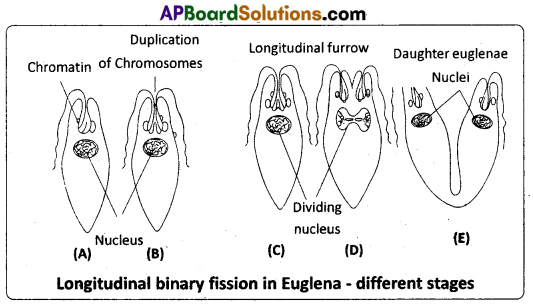
During the process of binary fission, the nucleus, basal granules, chromatophores, cytoplasm undergo division. The nucleus divides by mitosis into two daughter nuclei. Then the kinetosomes and the chromatophores also divide. At first, a longitudinal groove develops in the middle of the anterior end. This groove extends gradually towards the posterior end until the two daughter individuals are separated. One daughter Euglena retains the parental flagella. The other daughter individual develops new flagella from the newly formed basal granules. The stigma, paraflageliar body and contractile vacuole of the parent disappear. They develop afresh in both the daughter euglenae. The longitudinal binary fission is known as symmetrogenic division, because the two daughter euglenae resemble each other like ‘mirror images’.
Question 16.
What are the adverse effects of Tobacco ?
Answer:
Effect : Smoking increases the carbon monoxide (CO) level and reduces the oxygen level in the blood. Nicotine stimulates the adrenal gland to release adrenaline and nor-adrenajine into blood.
These hormones raise the blood pressure and increase the heart rate. Smoking is associated with bronchitis, emphysema, coronary heart disease, gastric ulcer and increases the incidence of cancers of throat, lungs, urinary bladder etc. Smoking also paves the way to hard drugs. Yet smoking is very pravalent in society, both among young and old. Tobacco chewing is associated with increased risk of cancer of the oral cavity.
Question 17.
Draw a neat labelled diagram of the mouth parts of cockroach.
Answer:
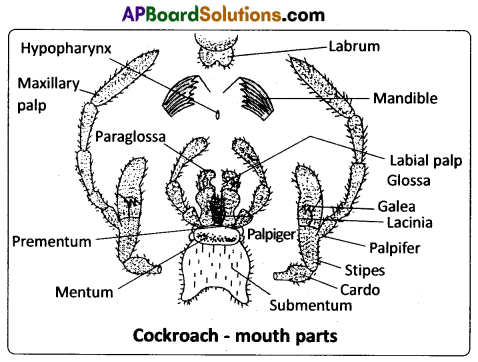
![]()
Question 18.
Describe ‘Green House Effect’.
Answer:
The greenhouse effect is a naturally occurring phenomenon that is responsible for heating of the Earth’s surface and atmosphere. It would be surprising to know that without greenhouse effect the average temperature of the Earth’s surface would have been a chilly -18° C rather than the present average of 15° C.
When sunlight reaches the outermost layer of the atmosphere, clouds and gases reflect about one-fourth of the incoming solar radiation, and absorb some of it. Almost half of the incoming solar radiation falls on the Earth’s surface and heats it up, while a small proportion is reflected back. The Earth’s surface re-emits heat in the form of infrared radiation but part of this does not escape into space as atmospheric gases (e.g: carbon dioxide, methane, etc.,) absorb a major fraction of it. The molecules of these gases radiate heat energy, and a major part of which again comes back to the Earth’s surface, thus heating it up once again. The above – mentioned gases – carbon dioxide and methane – are commonly known as green house gases, because they are responsible for the green house effect. Increase in the level of greenhouse gases has led to considerable heating of the Earth leading to global warming.
Section – C (2 × 8 = 16)
Note: Answer any two questions in 60 lines each.
Question 19.
Describe the life cycle of Plasmodium vivax in mosquito with ‘ the help of diagram.
Answer:
Life cycle of Plasmodium in mosquito (The mosquito phase) Ross cycle : When a female Anopheles mosquito bites and sucks the blood of a malaria patient, the gametocytes along with the other stages of the erythrocytic cycle reach the crop of mosquito. Here all the stages are digested except the gametocytes. Further part of the life cycle consists of:
i) Gametogony .
ii) Fertilization
iii) Formation of ookinete & oocysts
iv) Sporogony
i) Gametogony : The formation of male and female gametes from the gametocytes is called gametogony. It occurs in the lumen of the crop of mosquito.
Formation of male gametes : During this process, the nucleus of microgametocyte divides into eight daughter nuclei called pronuclei which reach the periphery. The cytoplasm is pushed out in the form of eight flagella like processes. Into each flagellum like process, one pronucleus enters and forms a micro gamete or male gamete. These male gametes show lashing movements like flagella and get separated from the cytoplasm of microgametocyte. This process is called exflagellation.
Formation of female gamete: The female gametocyte undergoes a few changes and transforms into a female gamete. This process is called maturation. The nucleus of the female gamete moves towards the periphery and the cytoplasm at that point forms a projection. This projected region is called the fertilization cone.
ii) Fertilization: The fusion of male and female gametes is called fertilization. It also occurs in the lumen of the crop of the mosquito. When an actively moving male gamete comes into contact with the fertilization cone of the female gamete, it enters it. The pronuclei and cytoplasm of these two gametes fuse with each other, resulting in the formation of a synkaryon. Since the two gametes are dissimilar in size, this process is known as anisogamy. The female gamete that bears the synkaryon is called the zygote which is round and non – motile.

iii) Formation of ookinete and oocysts : The zygote remains inactive for some time and then transforms into a long, slender,
motile, vermiform ookinete or vermicule within 18 to 24 hours. It pierces the wall of the crop and settles beneath the basement membrane. It becomes round and secretes a cyst around its body. This encysted ookinete is now called oocyst. About 50 to 500 oocysts are formed on the wall of the crop and appear in the form of small nodules. (Sir Ronald Ross identified these oocysts for the first time).

iv) Sporogony : The formation of sporozoites in the oocysts is called sporogony. According to Bano, the nucleus of the oocyst first undergoes reduction division followed by repeated mitotic divisions resulting in the formation of about 1,000 daughter nuclei. Each bit of nucleus is surrounded by a little bit of the cytoplasm and transforms into a sickle shaped sporozoite. Oocyst with such sporozoites is called sporocyst. When this sporocyst ruptures, the sporozoites are liberated into the haemocoel of the mosquito. From there, they travel into the salivary glands and are ready for infection. The life cycle of Plasmodium in mosquito is completed in about 10 to 24 days.
Question 20.
Describe the blood circulatory system of periplaneta in detail and draw a neat and labelled diagram of it.
Answer:
Circulatory system of Periplaneta : The circulatory system helps in the transportation of digested food, hormones etc., from one part to another in the body. Periplaneta has an open type of circulatory system as the blood, or haemohymph, flows freely within the body cavity or haemocoel. Blood vessels are poorly developed and open into spaces. Visceral organs located in the haemocoel are bathed in the blood. The three main parts associ-ated with the blood circulatory system of Periplaneta are the haemocoel, heart, and blood.
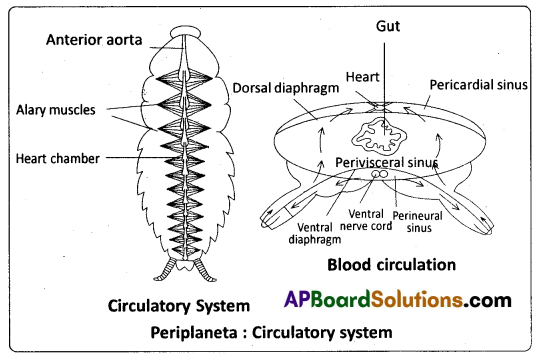
Haemocoel : The haemocoel of cockroach is divided into three sinuses by two muscular, horizontal membranes, called dorsal diaphragm or ‘pericardial septum’ and ventral diaphragm. Both the diaphragms have pores. There is a series of paired triangular muscles, called alary muscles. Every segment has one pair of these muscles situated on the lateral sides of the body. These are attached to the pericardial septum by their broad bases and to the terga by their pointed ends or apices. The three sinuses of the haemocoel are known as pericardial haemocoel orthe ‘dorsal sinus’, the perivisceral haemocoel or the ‘middle sinus’ and eternal haemocoel or ‘vental sinus’ or ‘perineural sinus’. The middle sinus is very large as it contains most of the viscera. The dorsal and ventral sinuses are small as they have only heart and nerve cord, respectively.
Heart : the heart lies in the pericardial haemocoel or dorsal sinus. It is a long, muscular, contractile tube found along the mid dorsal line, beneath the terga of the thorax and abdomen. It consists of 13 chambers. Every chamber opens into the other present in front of it. Three of the thirteen chambers are situated in the thorax and ten in the abdomen. Its posterior end is closed while the anterior end is continued forward as the anterior aorta. At the posterior side of each chamber, except the last, there is a pair of small apertures called ostia’ one on each side. Ostia have valves which allow the blood to pass only into the heart from the dorsal sinus.
Blood : The blood of Periplaneta is colourless and is called haemolymph. it consists of a fluid called plasma, and free blood corpuscles or haemocytes, which are ‘phagocytic’. The phagocytes are large in size and can ‘ingest’ foreign particles such as bacteria. There is no respiratory pigment in the blood and so it plays no major role in respiration. The important functions of the blood are :
- It absorbs digested food from the alimentary canal and distributes it to the rest of the body.
- It brings nitrogenous wastes from all parts of the body to the excretory organs for their elimination.
- It carries defensive phagocytes to the places of infection where they engulf the germs and disintegrating tissue parts.
- It transports secretions of the ductless glands to the target organs.
Circulation of blood: The blood flows forward in the heart by the contractions of its chambers. At the anterior end of the heart, the blood flows into the aorta and from there it enters the sinus of the head. From the head sinus, the blood flows into the perivisceral and sternal sinuses. On contraction of the alary muscles the pericardial septum is pulled down. This increases the volume of the pericardial sinus. Hence blood flows from the perivisceral sinus into the pericardial sinus through the appertures of the pericardial septum. On relaxation of the alary muscles, the pericardial septum moves upwards to its original position. This forces the blood, to enter the chambers of the heart through the ostia from the pericardial sinus.
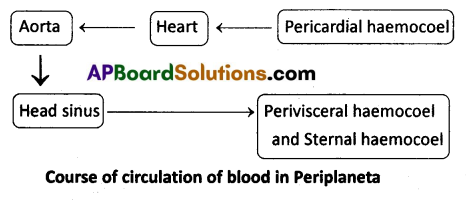
![]()
Question 21.
Describe different types of food chains that exist in an ecosystem.
Answer:
Energy flows into biological systems (ecosystems) from the Sun. The biological systems of environment include several food levels called trophic levels. A trophic level is composed of those organisms which have the same source of energy and having the same number of steps away from the sun. Thus a plant’s trophic level is one, while that of a herbivore – two, and that of the first level carnivore – three. The second and third levels of the carnivores occupy fourth and fifth trophic levels respectively.
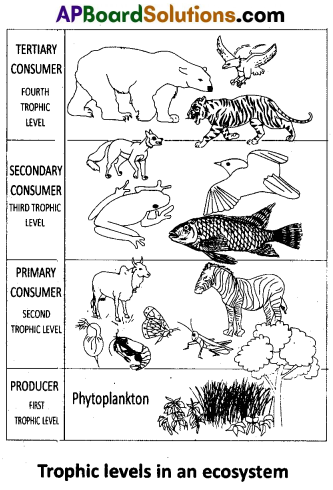
A given organism may occupy more than one trophic level simultaneously. One must remember that the trophic level represents a functional level. A given species may occupy more than one trophic level in the same ecosystem at the same time; for example, a sparrow is a primary consumer when it eats seeds, fruits, and a secondary consumer when it eats insects and worms.
The food energy passes from one trophic levels to another trophic level mostly from the lower to higher trophic levels. When the ‘path of food energy is ‘linear’, the components resemble the ‘links’ of a chain, and it is called ‘food chain’. Generally a food chain ends with decomposers. The three major types of food chains in an ecosystem are Grazing Food Chain, Parasitic Food Chain and Detritus Food Chain.
I. Grazing Food Chain (GFC): It is also known as predatory food chain. It begins with the green plants (producers) and the second, third and fourth trophic levels are occupied by the herbivores, primary carnivores and secondary carnivores respectively. In some food chains there is yet another trophic level – the climax carnivores. The number of trophic levels in food chains varies from 3 to 5 generally. Some examples for grazing food chain (GFC) are given below.
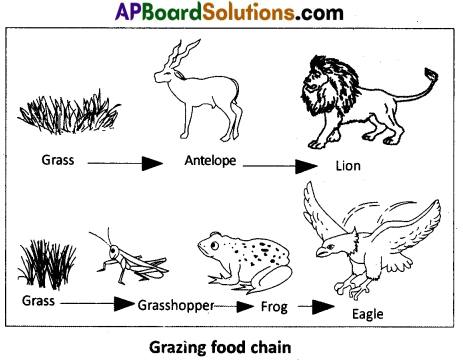

II. Parasitic food chain : Some authors included the ‘parasitic Food Chains’ as a part of the GFC. As in the case of GFCs, it also begins with the producers, the plants (directly or indirectly). However, the food energy passes from large organisms to small organisms in the parasitic chains. For instance, a tree which occupies the 1st trophic level provides shelter and food for many birds. These birds host many ectoparasites and endo-parasites. Thus, unlike in the predator food chain, the path of the flow of energy includes fewer, large sized organisms in the lower trophic levels, and numerous, small sized organisms in the successive higher trophic levels.
III. Detritus Food Chain : The detritus food chain (DFC) begins with dead organic matter (such as leaf litter, bodies of dead organisms). It is made up of Decomposers which are heterotrophic organisms, mainly the ‘fungi’ and ‘bacteria’. They meet their energy and nutrient requirements by degrading dead organic matter or detritus. These are also known as saprotrophs (sapro : to decompose)
Decomposers secrete digestive enzyme that breakdown dead and waste materials (such as faeces) into simple absorbable substances. Some examples of detritus food chains are :
-
-
- Detritus (formed from leaf litter) – Earthworms – Frogs – Snakes.
- Dead animals – Flies and maggots – Frogs – Snakes.
-
In an aquatic ecosystem, GFC is the major ‘conduit’ for the energy flow. As against this, in a terrestrial ecosystem, a much larger fraction of energy flows through the detritus food chain than through the GFC. Detritus food chain may be connected with the grazing food chain at some levels. Some of the organisms of DFC may form the prey of the GFC animals. For example, in the detritus food chain given above, the earthworms of the DFC may become the food of the birds of the GFC. It is to be understood that food chains are not ‘isolated’ always.